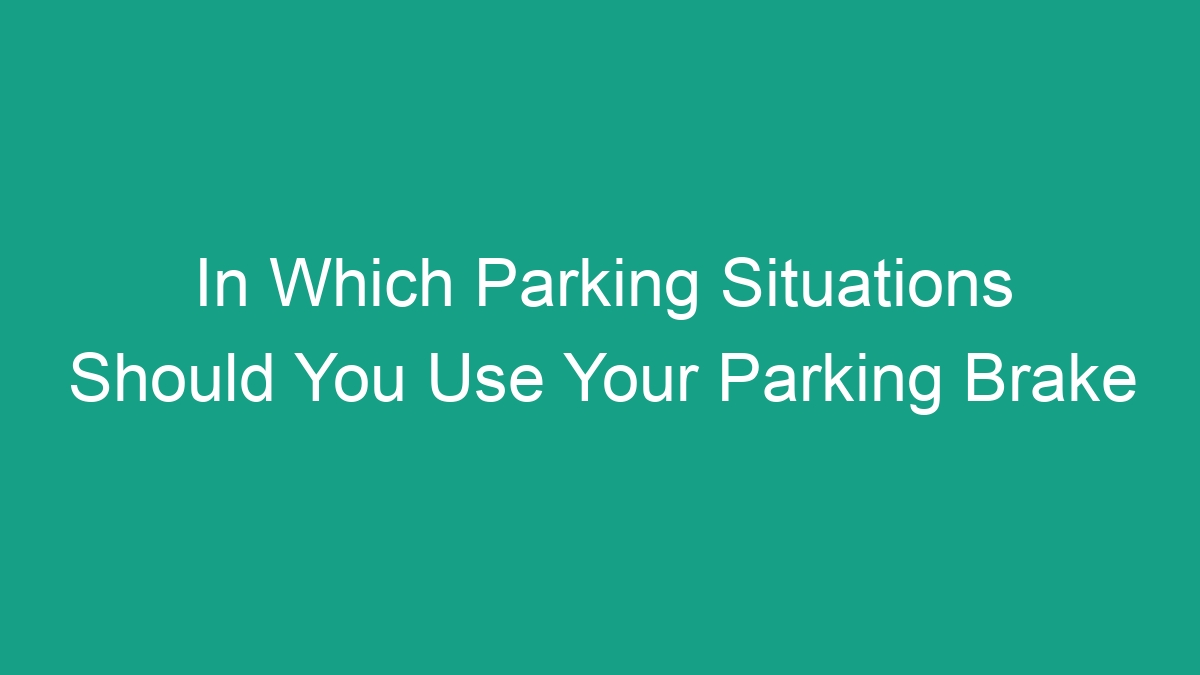
Introduction
Parking brakes, also known as handbrakes or emergency brakes, are a crucial component of a vehicle’s safety system. While most drivers are familiar with the general concept of a parking brake, there is often confusion about when and where it should be used. In this article, we will discuss the various parking situations in which you should use your parking brake to ensure safety and prevent damage to your vehicle.
Why Use Your Parking Brake?
Before delving into specific parking situations, it’s important to understand the purpose of the parking brake. Unlike the primary brake system, which is operated by foot and controls the vehicle’s main stopping power, the parking brake is designed to hold the vehicle in place when it is parked. This additional measure of security is particularly important when parking on slopes or inclines, as it prevents the vehicle from rolling or moving unintentionally.
Using the parking brake also reduces stress on the transmission and allows for smoother engagement of the transmission’s parking pawl, which can prolong the life of the transmission. Moreover, in the event of a failure in the primary brake system, the parking brake can serve as a backup to bring the vehicle to a stop.
When to Use Your Parking Brake
Now that we understand the importance of the parking brake, let’s explore the specific parking situations in which it should be used.
Parking on a Slope
One of the most critical times to use your parking brake is when parking on a slope. Whether it’s a steep hill or a gentle incline, using the parking brake is essential to prevent the vehicle from rolling. Engage the parking brake before shifting the vehicle into “park” to ensure that the weight of the vehicle is resting on the brake rather than the transmission’s parking mechanism.
Parallel Parking
When parallel parking on a street or in a parking lot, using the parking brake can provide an extra level of security. Engaging the parking brake before turning off the engine helps to prevent the vehicle from rolling forward or backward, especially if the surface is slick or if there is an incline.
Extended Parking
If you’ll be leaving your vehicle parked for an extended period, using the parking brake is advisable. This practice helps to reduce the strain on the transmission and prevents the vehicle from rolling if the transmission slips or fails. Additionally, using the parking brake can provide added security against theft, as it makes it more difficult for a thief to roll the vehicle away.
Manual Transmission Vehicles
In vehicles equipped with a manual transmission, using the parking brake is particularly important. When parked, always engage the parking brake before shifting into “neutral” or removing your foot from the clutch. This practice prevents stress on the transmission and provides an added layer of safety in the event of an accidental movement of the gearshift.
When Not to Use Your Parking Brake
While the parking brake is an essential safety feature, there are certain situations in which it should not be used.
In Winter Conditions
In regions with extreme cold and the potential for freezing, it’s important to exercise caution when using the parking brake. If the parking brake becomes frozen, it may not disengage properly, leading to difficulties in driving the vehicle. In these cases, it may be best to avoid using the parking brake and instead rely on leaving the vehicle in gear, particularly in manual transmission vehicles, to prevent rolling.
After Driving Through Water
If you’ve driven through deep water, it’s advisable not to use the parking brake until the brakes have had a chance to dry out. Water can cause the brakes to become less effective, and engaging the parking brake in this situation may lead to it becoming stuck in the “on” position.
Conclusion
In conclusion, the parking brake is a crucial safety feature that should be used in specific parking situations to prevent the vehicle from rolling and to reduce stress on the transmission. By understanding when to use your parking brake and when to avoid using it, you can ensure the safety and longevity of your vehicle. Remember to always engage the parking brake when parking on a slope, during parallel parking, for extended parking periods, and in manual transmission vehicles. By following these guidelines, you can enjoy added peace of mind and protect your vehicle from potential damage.



